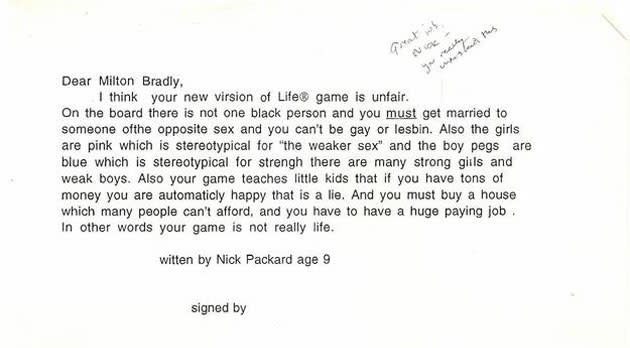 The Daily Buzz
The Daily BuzzNick Packard, 9, attacks Milton Bradley for unfair Game of Life
The child wrote a letter to the game pioneer challenging the board game for its gender stereotypes and unrealistic socioeconomic living situations
A nine-year-old-boy has written a letter to Milton Bradley criticizing the new version of the Game of Life and calling it unfair for what participants are supposed to do to succeed.
Nick Packard starts off by pointing out that there are no black people in the game and writes, "you must get married to someone of the opposite sex and you can't be gay or lesbian." He attacks the girls are pink and boys are blue stereotype and comes down hard on the game for teaching kids that money, marriage, a well-paying job and a house will make people happy.
The letter is going viral.
It's unclear if parents put Packard up to writing this or how big of an influence they had on the letter, but the kid has a point.
Today, many people are finding happiness without marrying people of the opposite sex. Many, at least in Canada, are marrying people of the same sex and an astonishing number of people are living alone. In the U.S., there are about 32.7 million people living alone, according to a recent CBS Sunday Morning story. Roughly four in 10 households are single-person homes and that's significantly higher in places like Manhattan (50 per cent), Seattle (42 per cent), Denver (40.4) and San Francisco (39.7 per cent).
The Game of Life may say you have to marry to do well, but don't tell that to New Yorker Kate Bolick. She said living alone has lots of advantages.
"I like being able to control my time on my own terms," said Bolick, who has a book deal to write about living alone, to CBS. "I like that I can eat when I want, read when I want, see friends when I want to. I like that I don't have to make compromises in the way I spend my time."
Packard also takes issue with home ownership. Back in 1984 the average price of a house in Canada was $76,214. Today it's $369,677 and rising in some places at almost 10 per cent a year. A better way to look at that is 28 year ago a house cost a family about 1.6 times their annual income. Now families are looking at a multiple of six. Home ownership just isn't in the books for many people unless they want to spend their lives commuting.
Finally, most people aren't super rich. The head of a typical public company made $9.6 million in 2011, according to recent analysis by The Associated Press using data from Equilar. While that was up six per cent last year alone, the average Canadian worker's take-home pay has only risen about 25 per cent in the past 28 years. The average Canadian makes about $48,300 a year and the average annual after-tax family income in this country is about $60,000.
Maurice of Barstool Sports points out the game also doesn't include calls from debt collecting agencies, pregnancy scares and child support payments.
While Packard makes many true points, it's sad how early he has figured out how unrealistic this game is. Instead of playing with Lego, he seems to have the frustration of a recent university graduate who is having trouble finding work. This is the case for about 14 per cent of Canadians, but Packard doesn't mention this in his letter. If Packard has already figured this out, we can't imagine how disgruntled he'll be in another 15 years.
Sadly, Milton Bradley will never read this letter. The American game pioneer passed away in 1911, but maybe new versions will include more factors used in quality of life indexes. Maybe they should introduce a game where participants try their hardest to move to Vancouver. The city, along with British Columbia's Victoria, Kelowna and Abbotsford have been ranked as the places with the highest quality of life in Canada.
While many Canadians and others around the world may no longer be "winning" the Game of Life style, that doesn't seem to stop people from being happy. Good point, kid, the Game of Life seems quite outdated. It's time to play a game called Quality of Life, where people score points for having good health and community life, among other factors.


